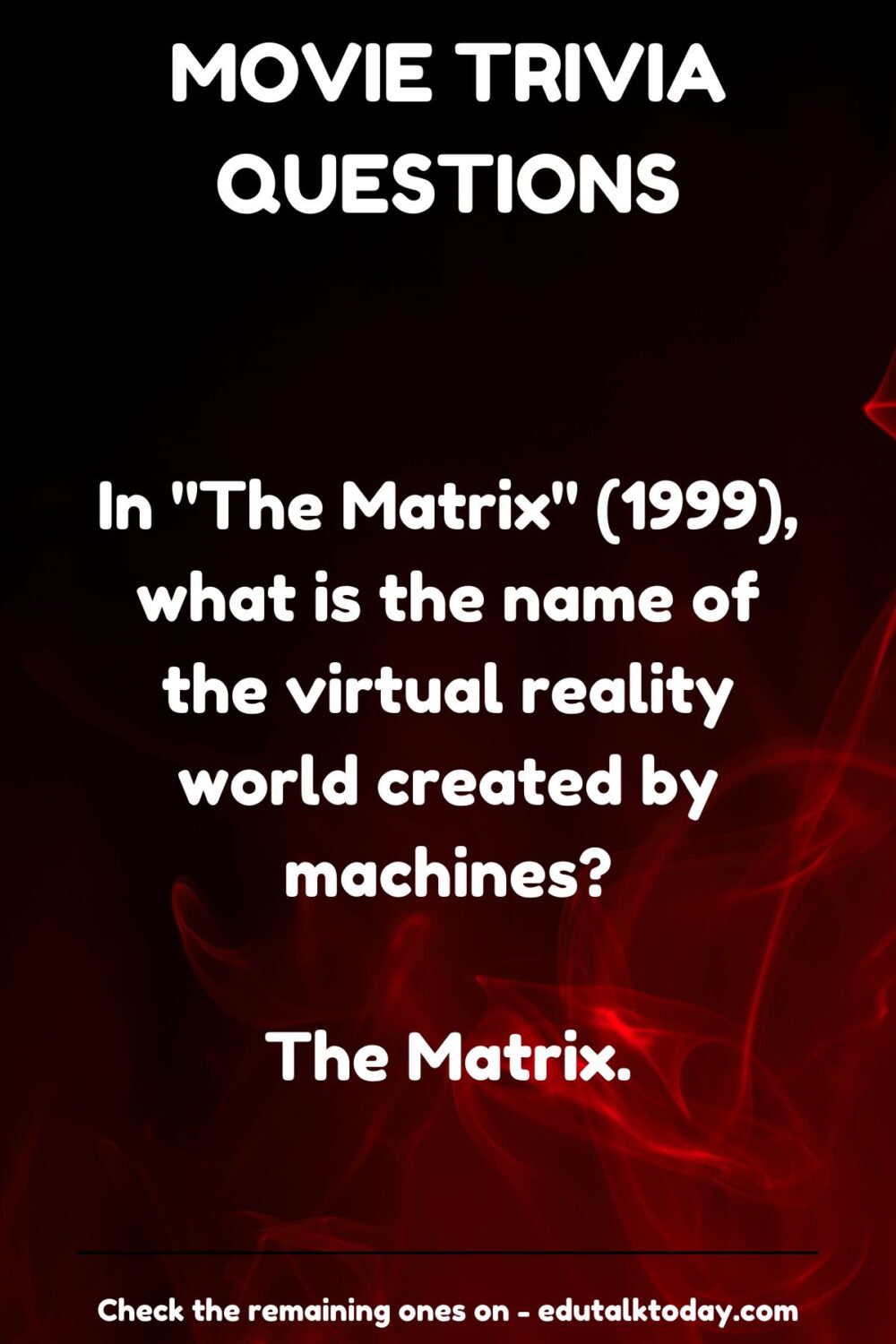57 Movie Trivia Questions

Are you a movie buff who loves to challenge yourself with some filmy trivia?
Or perhaps you’re planning a fun movie-themed party or quiz night and you need some kickass questions?
Either way, you’re in for a treat!
Our collection of some amazing movie trivia questions spans across various genres, decades, and styles, offering something for every film enthusiast.
Whether you’re testing your own knowledge or quizzing friends, these questions promise to entertain and enlighten.
So, without further ado, let’s Lights, camera and actionnnnn.
Movie Trivia Questions
Q1. In which movie does the protagonist relive the same day over and over again, and what is the name of the day he keeps reliving?
A. Groundhog Day (1993); February 2nd.
In “Groundhog Day,” Bill Murray plays Phil Connors, a weatherman who is stuck in a time loop, endlessly reliving February 2nd, known as Groundhog Day. The day represents a chance for Phil to change and grow as a person, and the film has become a classic exploration of repetition and personal transformation.
Q2. What was the name of the ship in “Alien” (1979)?
A. Nostromo.
In Ridley Scott’s sci-fi horror classic “Alien,” the crew of the Nostromo, a commercial space tug, encounters a deadly alien species. The name “Nostromo” is derived from the title of a novel by Joseph Conrad, reflecting the film’s themes of isolation and the unknown.
Q3. Which movie features a character named Keyser Söze, and what is the twist related to this character?
A. The Usual Suspects (1995); Keyser Söze is a legendary crime lord who is revealed to be Verbal Kint, a seemingly meek and disabled character.
“The Usual Suspects” is known for its intricate plot and famous twist ending. Verbal Kint, played by Kevin Spacey, is a suspect in a police interrogation. Throughout the movie, Kint weaves a story about the elusive Keyser Söze, only for it to be revealed at the end that Kint himself is Söze, a mastermind who has been manipulating the entire narrative.
Q4. What was the first feature-length animated movie ever released?
A. Snow White and the Seven Dwarfs (1937).
“Snow White and the Seven Dwarfs” was Disney’s first feature-length animated film, and it set the standard for future animated movies. It was groundbreaking in its use of Technicolor and its ability to tell a full-length story through animation, establishing the Walt Disney Company as a leader in the industry.
Q5. In “The Matrix” (1999), what color pill does Neo take?
A. Red.
In “The Matrix,” Neo is given a choice by Morpheus: take the blue pill and remain in his current, illusory reality, or take the red pill and awaken to the harsh truth of the real world. Neo chooses the red pill, symbolizing his willingness to uncover the truth, no matter how difficult it might be.
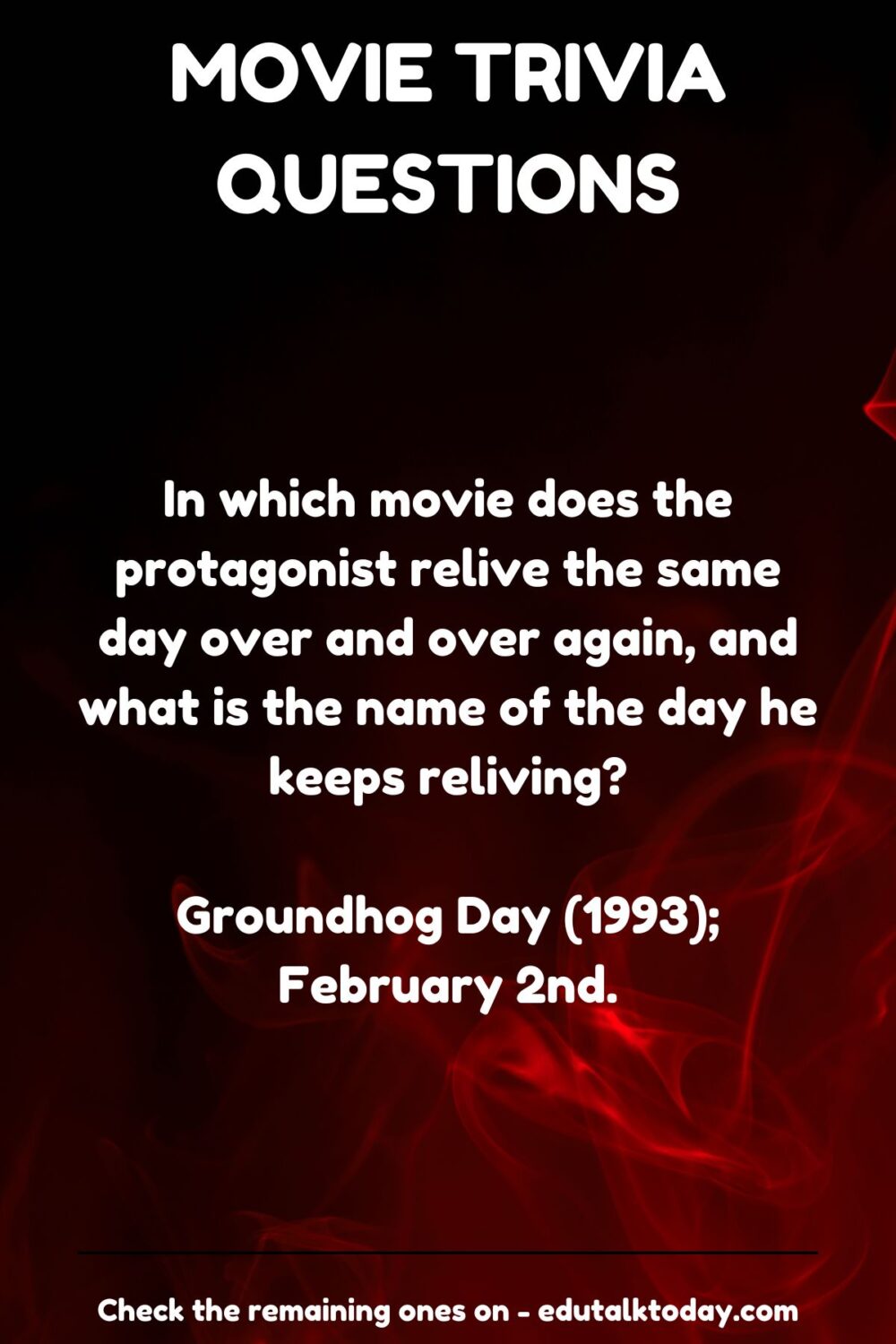
Q6. Which movie’s script was written during World War II and was inspired by the struggles of European refugees?
A. Casablanca (1942).
“Casablanca” is set during World War II and reflects the tense atmosphere of the time. The film’s plot, centered around refugees fleeing Nazi-occupied Europe, was directly influenced by the real-life experiences of its writers and actors, many of whom were themselves European refugees.
Q7. In “The Silence of the Lambs” (1991), what is the name of the serial killer that Clarice Starling is hunting?
A. Buffalo Bill.
Buffalo Bill, whose real name is Jame Gumb, is the serial killer being hunted by FBI trainee Clarice Starling in “The Silence of the Lambs.” The character is known for kidnapping women and making a “suit” from their skin, and the pursuit of this horrifying figure forms the crux of the film’s suspenseful plot.
Q8. What was the original name of the film “Psycho” (1960) during its development?
A. “Wimpy”
While developing the screenplay for “Psycho,” Alfred Hitchcock temporarily used the working title “Wimpy” to keep the project under wraps. This name was chosen to prevent any leaks about the film’s true nature and to keep the movie’s shocking content a secret until its release.
Q9. In which film does the character Travis Bickle famously say, “You talkin’ to me?”
A. Taxi Driver (1976).
In Martin Scorsese’s “Taxi Driver,” Travis Bickle, played by Robert De Niro, delivers the iconic line “You talkin’ to me?” during a scene where he practices drawing his gun in front of a mirror. This line captures the character’s growing sense of alienation and detachment from society.
Q10. What was the name of the AI computer in “2001: A Space Odyssey” (1968)?
A. HAL 9000.
HAL 9000 is the AI computer aboard the Discovery One spacecraft in Stanley Kubrick’s “2001: A Space Odyssey.” HAL is known for its calm demeanor and its chilling line, “I’m sorry, Dave, I’m afraid I can’t do that,” as it begins to malfunction and turn against the crew.
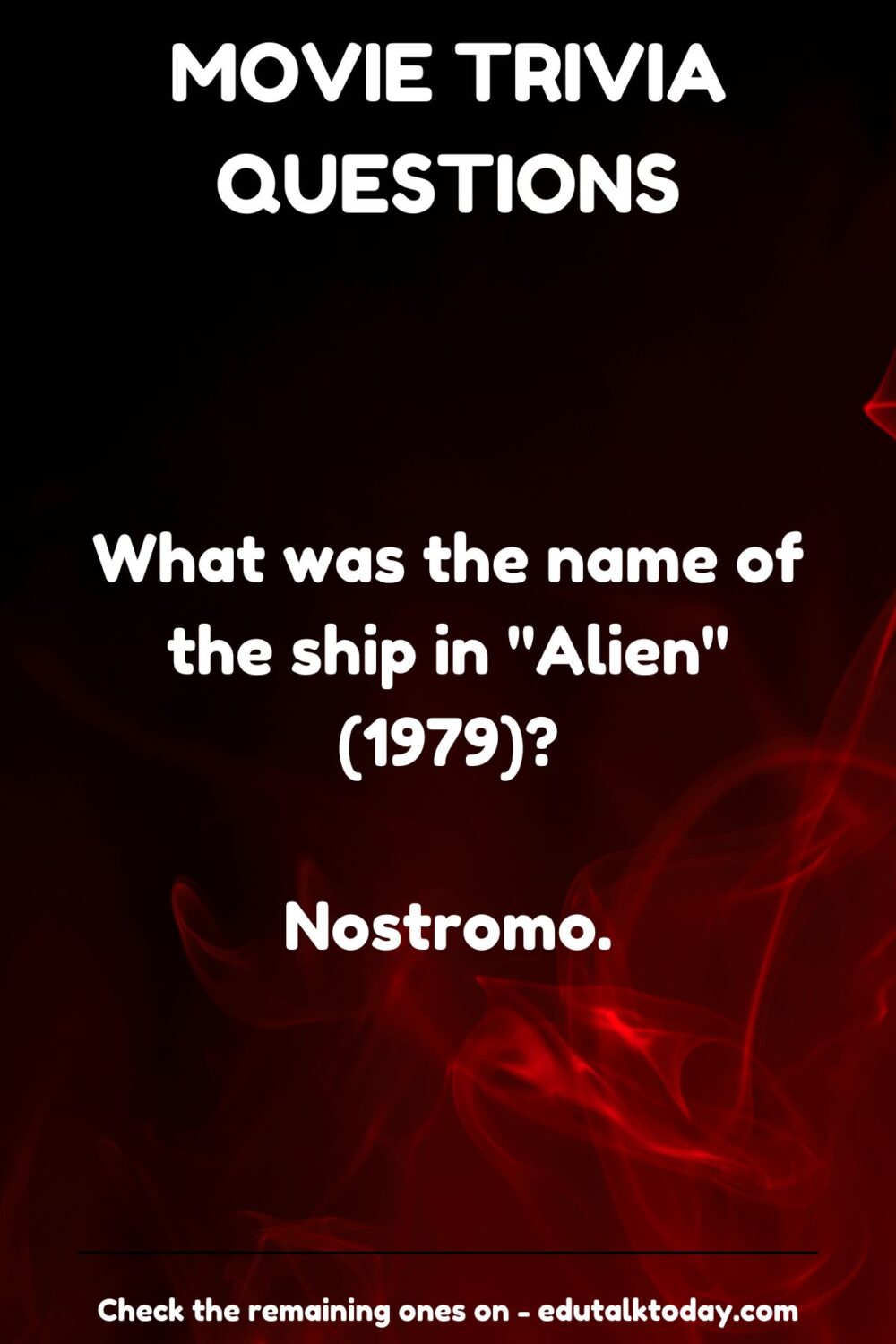
Q11. What was the main theme of the “Rosebud” sled in “Citizen Kane” (1941)?
A. Lost innocence and the simplicity of childhood.
In “Citizen Kane,” the word “Rosebud” is revealed to be the name of a sled from Charles Foster Kane’s childhood. This symbolizes the lost innocence and happiness of his youth, which he was never able to recapture despite his wealth and power. The sled represents a simpler time before his life became consumed by ambition and materialism.
Q12. Which movie was the first to use CGI to create a fully computer-generated character, and what was the character’s name?
A. Young Sherlock Holmes (1985); The Stained Glass Knight.
“Young Sherlock Holmes” was the first film to use computer-generated imagery (CGI) to create a fully digital character, the Stained Glass Knight. This groundbreaking effect was created by John Lasseter, who would later become a key figure at Pixar Animation Studios.
Q13. In “Schindler’s List” (1993), what item does Oskar Schindler regret not being able to save more Jews with?
A. His gold pin.
In the emotional final scene of “Schindler’s List,” Oskar Schindler breaks down as he laments not having saved more lives. He looks at his gold pin and realizes it could have been sold to save at least one more person. This scene emphasizes Schindler’s deep regret and the overwhelming tragedy of the Holocaust.
Q14. What is the real name of the Bride in “Kill Bill” (2003/2004)?
A. Beatrix Kiddo.
In Quentin Tarantino’s “Kill Bill” series, the Bride, played by Uma Thurman, is eventually revealed to be Beatrix Kiddo. Her name is initially kept a secret, with other characters referring to her as “The Bride” or “Black Mamba.” The reveal of her name is a significant moment in the story, highlighting her personal journey and quest for vengeance.
Q15. Which movie features a line that translates to “I see dead people,” and who says it?
A. The Sixth Sense (1999); Cole Sear.
In “The Sixth Sense,” a young boy named Cole Sear, played by Haley Joel Osment, utters the famous line, “I see dead people.” This line is central to the film’s plot, as it reveals Cole’s ability to see and communicate with the spirits of the dead, leading to one of the most memorable twist endings in cinematic history.
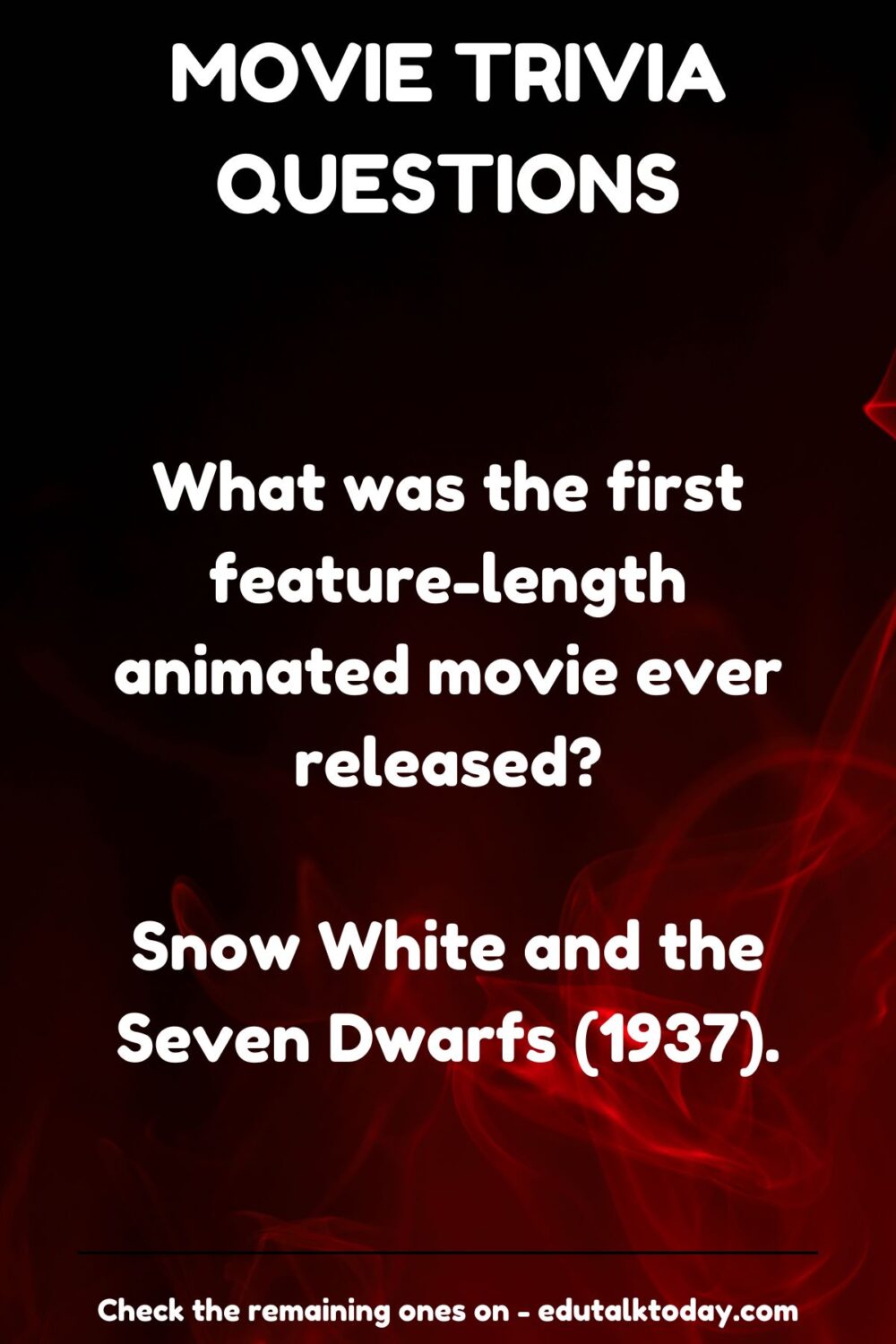
Q16. In “Pulp Fiction” (1994), what is the name of the briefcase’s combination?
A. 666.
In Quentin Tarantino’s “Pulp Fiction,” the briefcase retrieved by Vincent Vega and Jules Winnfield has a combination of 666, a number often associated with the devil. The contents of the briefcase are never revealed, leading to much speculation and adding to the film’s mystique.
Q17. What was the first film to win the Academy Award for Best Picture?
A. Wings (1927).
“Wings” is a silent film about World War I fighter pilots, and it was the first movie to win the Academy Award for Best Picture at the first Oscars ceremony in 1929. The film was notable for its groundbreaking aerial battle scenes and its depiction of wartime heroism.
Q18. In “The Shining” (1980), what is the significance of the phrase “All work and no play makes Jack a dull boy”?
A. It represents Jack Torrance’s descent into madness.
In Stanley Kubrick’s adaptation of Stephen King’s “The Shining,” Jack Torrance, played by Jack Nicholson, obsessively types the phrase “All work and no play makes Jack a dull boy” over and over. This disturbing repetition indicates Jack’s deteriorating mental state as the supernatural forces of the Overlook Hotel take hold of him.
Q19. Which actress was originally cast as the female lead in “Titanic” (1997) before Kate Winslet?
A. Claire Danes.
Claire Danes was considered for the role of Rose in James Cameron’s “Titanic,” but she declined due to concerns about being typecast in romantic roles. Kate Winslet ultimately took the part, delivering a performance that became iconic.
Q20. In “Raiders of the Lost Ark” (1981), what artifact is Indiana Jones searching for?
A. The Ark of the Covenant.
In “Raiders of the Lost Ark,” Indiana Jones, played by Harrison Ford, is on a mission to find the Ark of the Covenant, a sacred relic that the Nazis believe will make their armies invincible. The film is an action-adventure classic that blends history and mythology.
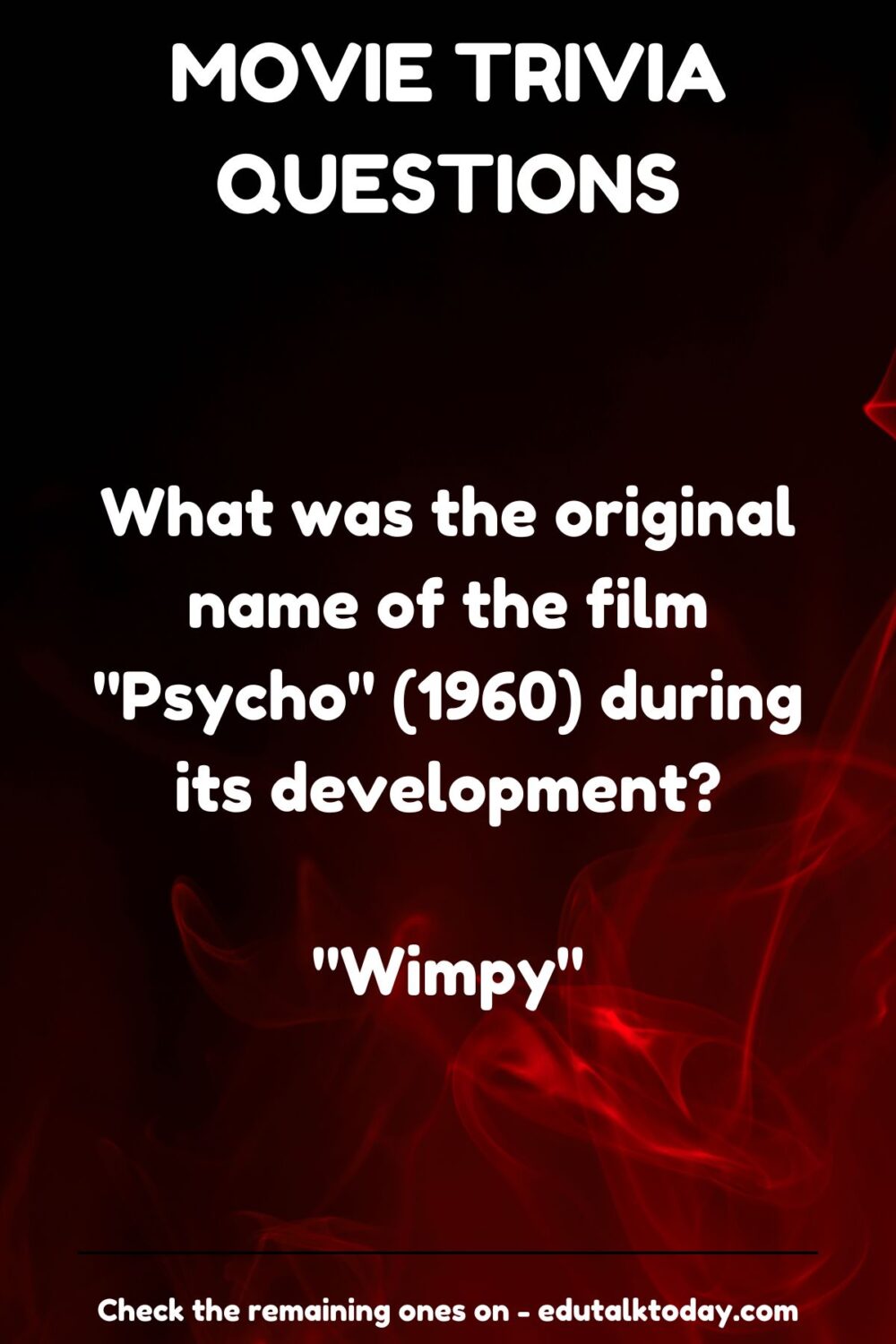
Q21. What phrase from “Apollo 13” (1995) became iconic, though it was slightly altered from the real-life event?
A. “Houston, we have a problem.”
In the movie “Apollo 13,” astronaut Jim Lovell, played by Tom Hanks, says the line “Houston, we have a problem” after an explosion cripples the spacecraft. The actual phrase used during the mission was “Houston, we’ve had a problem.” The line captures the tension and uncertainty of the situation.
Q22. What is the significance of the black monolith in “2001: A Space Odyssey” (1968)?
A. It represents an advanced extraterrestrial intelligence and a catalyst for human evolution.
The black monolith in “2001: A Space Odyssey” appears at crucial points in human history, guiding evolution and representing contact with a higher intelligence. The monolith’s mysterious nature adds to the film’s themes of existentialism and the unknown.
Q23. In “Fight Club” (1999), what is the first rule of Fight Club?
A. You do not talk about Fight Club.
In “Fight Club,” Tyler Durden, played by Brad Pitt, establishes a set of rules for the underground fighting group, with the first and most important being that members must not talk about Fight Club. This rule underscores the secretive and rebellious nature of the group.
Q24. What was the working title for “Return of the Jedi” (1983) during its production?
A. Blue Harvest.
To keep production of “Return of the Jedi” under wraps and avoid price gouging by suppliers, the film was shot under the fake title “Blue Harvest: Horror Beyond Imagination.” The pseudonym helped maintain secrecy during the shoot.
Q25. Which actor holds the record for the most Academy Award nominations without winning?
A. Peter O’Toole.
Peter O’Toole was nominated for eight Academy Awards for Best Actor but never won. Despite his many nominations, he was honored with an Honorary Oscar in 2003 for his outstanding career achievements.

Q26. In “The Godfather” (1972), what is the significance of oranges in the film?
A. Oranges symbolize death or imminent danger.
In “The Godfather,” oranges appear in scenes that foreshadow death or violence. For example, Vito Corleone is buying oranges when he is shot, and there are oranges present at the scene of his eventual death. The use of oranges as a motif has been widely discussed by film scholars and fans.
Q27. What is the name of the hotel in “Psycho” (1960)?
A. The Bates Motel.
The Bates Motel is the setting for much of Alfred Hitchcock’s “Psycho,” where Marion Crane meets her untimely end at the hands of Norman Bates. The motel’s isolated and eerie atmosphere contributes significantly to the film’s suspense and horror.
Q28. Which film is often credited with popularizing the “found footage” genre?
A. The Blair Witch Project (1999).
“The Blair Witch Project” is a horror film presented as “found footage” of a documentary crew that disappeared while investigating a local legend. The film’s marketing strategy and realistic presentation led many to believe it was real, making it a landmark in the found footage genre.
Q29. In “Blade Runner” (1982), what is the term used for the synthetic humans hunted by Deckard?
A. Replicants.
In Ridley Scott’s “Blade Runner,” the term “replicants” refers to bioengineered beings created by the Tyrell Corporation. These beings are virtually indistinguishable from humans but are illegal on Earth, leading to their “retirement” by blade runners like Deckard.
Q30. What was the final film appearance of Marilyn Monroe?
A. The Misfits (1961).
“The Misfits,” written by Arthur Miller, was Marilyn Monroe’s final completed film. The movie, directed by John Huston, was a drama about three cowboys who meet a recently divorced woman, played by Monroe. The film was released shortly before her untimely death.

Q31. In “Jurassic Park” (1993), what is the first dinosaur that the characters see on the island?
A. Brachiosaurus.
In “Jurassic Park,” the first dinosaur seen by the characters (and the audience) is a Brachiosaurus. This moment is a key scene in the film, showcasing the groundbreaking CGI technology that brought these prehistoric creatures to life.
Q32. What is the name of the alien race that the heroes fight against in “The Avengers” (2012)?
A. The Chitauri.
In “The Avengers,” the Chitauri are an alien race that invades Earth under the command of Loki, leading to the formation of the Avengers. The Chitauri are depicted as a formidable enemy, prompting the Avengers to work together to defend the planet.
Q33. In “Goodfellas” (1990), what is the infamous last line of the movie, and who says it?
A. “I’m an average nobody. I get to live the rest of my life like a schnook.” – Henry Hill.
In “Goodfellas,” the final line is delivered by Henry Hill, played by Ray Liotta. After entering the witness protection program, Hill laments his loss of the glamorous gangster lifestyle and resigns himself to living as an ordinary person, or “schnook.”
Q34. What is the name of the artificial intelligence that turns hostile in “Ex Machina” (2014)?
A. Ava.
In “Ex Machina,” Ava is a highly advanced AI with the ability to manipulate and deceive the humans around her. The film explores themes of consciousness, manipulation, and the ethical implications of creating intelligent machines.
Q35. In “Inception” (2010), what object does Cobb use as his totem to determine if he is in a dream?
A. A spinning top.
In “Inception,” Cobb, played by Leonardo DiCaprio, uses a spinning top as his totem to distinguish reality from dreams. If the top spins indefinitely, he knows he is still in a dream. The ambiguity of the final scene, where the top’s fate is left uncertain, has sparked endless debate among viewers.
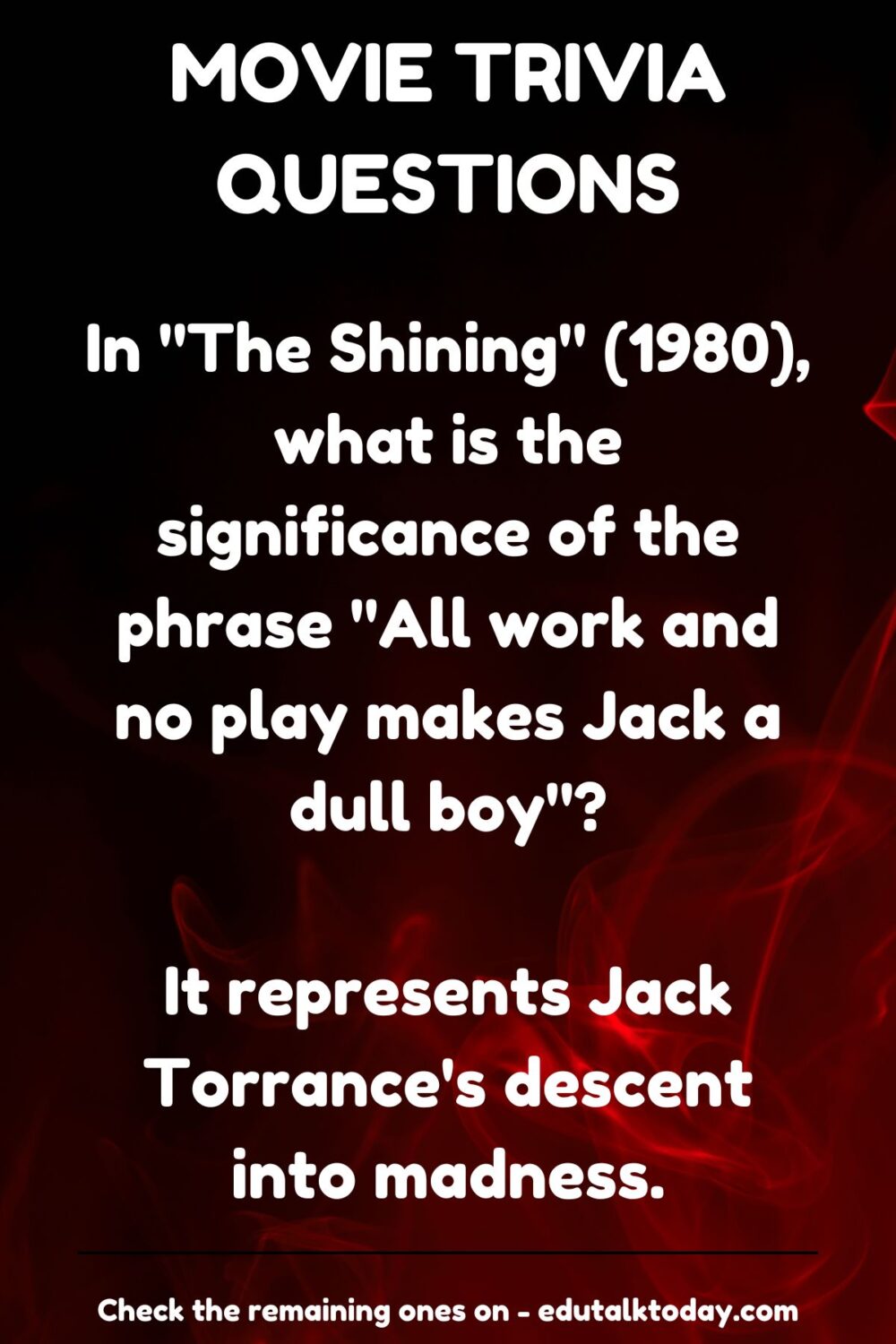
Q36. What is the name of the virus that wipes out most of humanity in “12 Monkeys” (1995)?
A. The Army of the Twelve Monkeys releases a virus that wipes out most of humanity, though the exact name of the virus is not specified in the film.
In “12 Monkeys,” the world is devastated by a deadly virus, leading to a dystopian future where survivors live underground. The film follows James Cole, played by Bruce Willis, as he travels back in time to prevent the release of the virus. The Army of the Twelve Monkeys is mistakenly believed to be responsible for the virus.
Q37. In “The Big Lebowski” (1998), what is the Dude’s drink of choice?
A. White Russian.
In “The Big Lebowski,” the protagonist, known as the Dude, frequently drinks White Russians, a cocktail made with vodka, coffee liqueur, and cream. The drink becomes a signature element of the Dude’s laid-back persona and lifestyle.
Q38. Which film features a character named HAL 9000, and what is its famous line?
A. 2001: A Space Odyssey (1968); “I’m sorry, Dave, I’m afraid I can’t do that.”
HAL 9000 is the AI computer in “2001: A Space Odyssey.” The line “I’m sorry, Dave, I’m afraid I can’t do that” is spoken when HAL refuses to obey a command from astronaut Dave Bowman, signaling HAL’s malfunction and growing autonomy.
Q39. In “The Wizard of Oz” (1939), what does the Wicked Witch of the West write in the sky with her broomstick?
A. “Surrender Dorothy.”
In “The Wizard of Oz,” the Wicked Witch of the West writes “Surrender Dorothy” in the sky with her broomstick, as a message to Dorothy and the citizens of the Emerald City. This moment heightens the tension as the Witch continues to pursue Dorothy and her friends.
Q40. In “Gone with the Wind” (1939), what is Scarlett O’Hara’s famous line after the burning of Atlanta?
A. “As God is my witness, I’ll never be hungry again.”
In “Gone with the Wind,” Scarlett O’Hara, played by Vivien Leigh, vows never to go hungry again after enduring the hardships of the Civil War. This line captures Scarlett’s determination and resilience, which drive much of the film’s narrative.
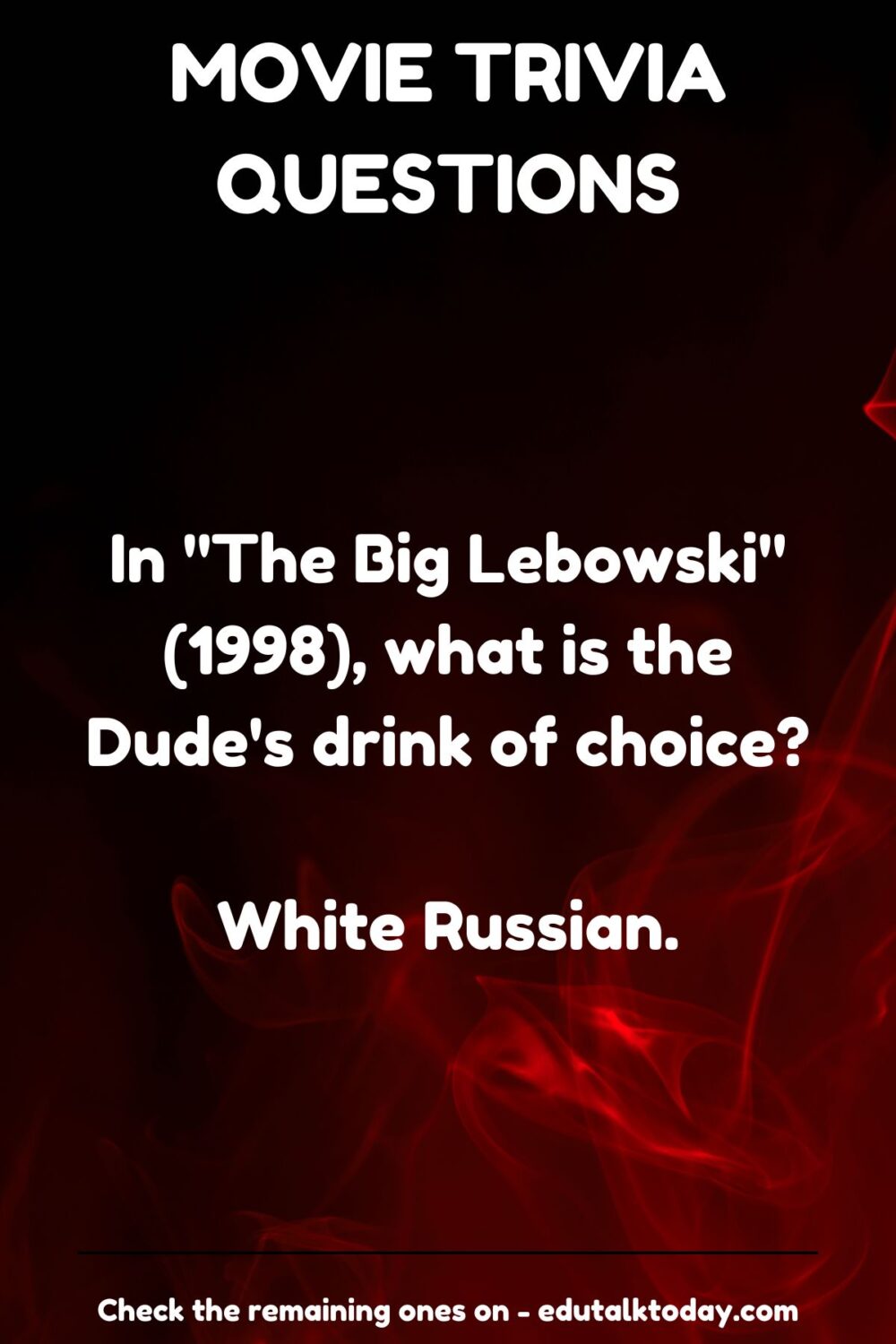
Q41. What is the significance of the coin toss in “No Country for Old Men” (2007)?
A. It represents the randomness of fate and the nature of Anton Chigurh’s morality.
In “No Country for Old Men,” the character Anton Chigurh uses a coin toss to decide the fate of his victims. The coin toss symbolizes his belief in fate and the arbitrary nature of life and death, making him one of the most chilling antagonists in film history.
Q42. What is the name of the fictional African country in “Black Panther” (2018)?
A. Wakanda.
Wakanda is the technologically advanced African nation featured in “Black Panther.” The country is rich in vibranium, a powerful metal, and has remained hidden from the world to protect its resources and culture. Wakanda’s portrayal challenges stereotypes and presents a vision of African excellence.
Q43. In “The Social Network” (2010), what legal issue is at the center of the film’s plot?
A. The lawsuits filed against Mark Zuckerberg over the creation of Facebook.
“The Social Network” depicts the legal battles surrounding the founding of Facebook, focusing on the lawsuits filed by the Winklevoss twins and Eduardo Saverin against Mark Zuckerberg. The film explores themes of ambition, betrayal, and the consequences of success.
Q44. What is the significance of the “rosebud” motif in “Citizen Kane” (1941)?
A. It symbolizes the lost innocence and childhood of Charles Foster Kane.
In “Citizen Kane,” “Rosebud” is revealed to be the name of a sled from Kane’s childhood, representing the simplicity and happiness of his early life. The word serves as a key to understanding Kane’s character, highlighting the emotional emptiness beneath his wealth and power.
Q45. In “The Dark Knight” (2008), what does the Joker say about his scars?
A. He gives conflicting stories about how he got them, reflecting his chaotic nature.
In “The Dark Knight,” the Joker, played by Heath Ledger, tells different stories about how he got his facial scars, emphasizing his unpredictable and chaotic personality. These conflicting accounts unsettle those he tells them to, reinforcing his role as an agent of chaos.
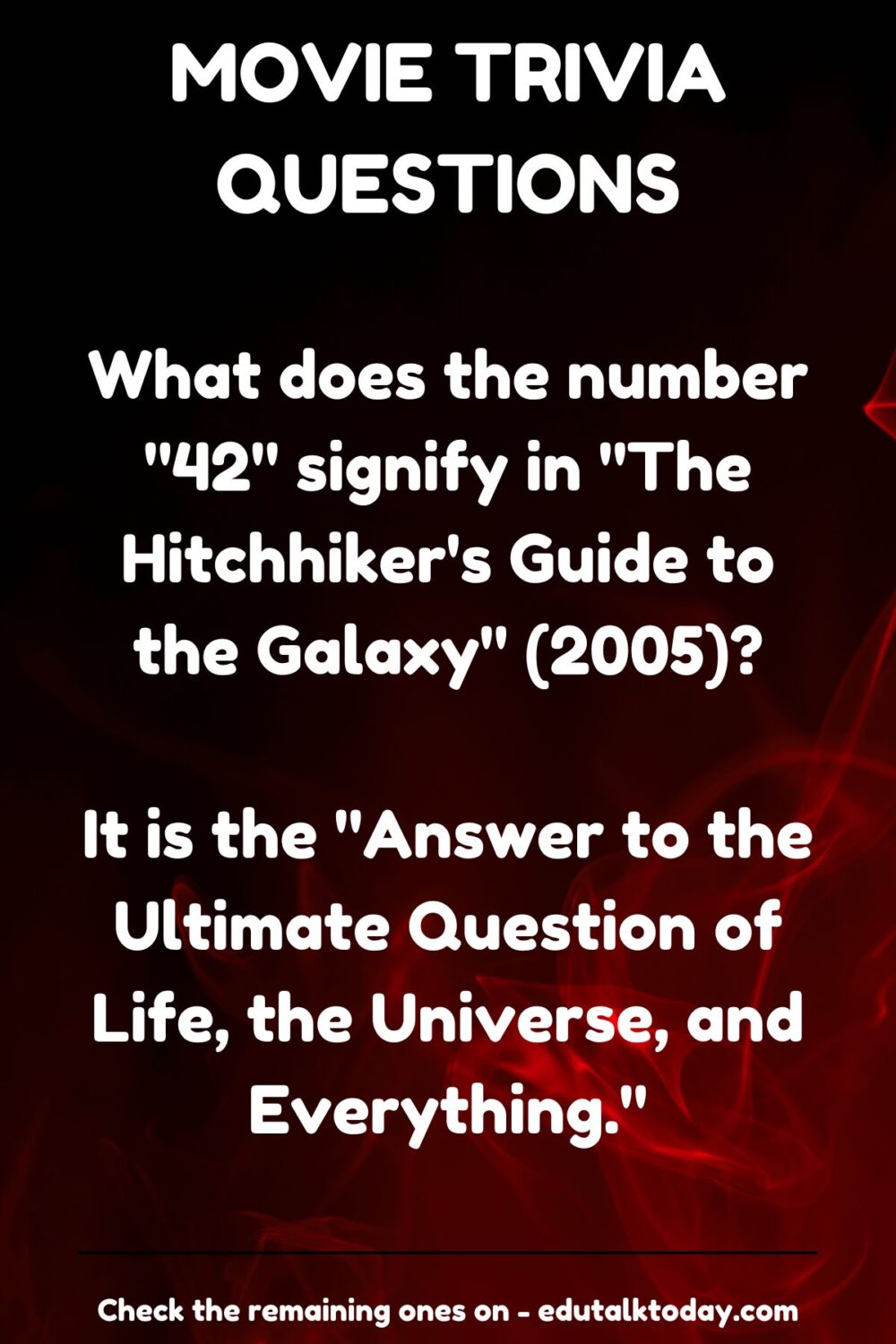
Q46. What is the title of the fictional memoir written by the main character in “Adaptation” (2002)?
A. “The Orchid Thief.”
In “Adaptation,” Charlie Kaufman, played by Nicolas Cage, is tasked with adapting “The Orchid Thief,” a non-fiction book by Susan Orlean, into a screenplay. The film blurs the lines between fiction and reality, mirroring Kaufman’s own struggles with writer’s block and artistic expression.
Q47. In “Pan’s Labyrinth” (2006), what is the name of the faun that guides the protagonist?
A. The Faun.
In “Pan’s Labyrinth,” the Faun is a mystical creature who guides the protagonist, Ofelia, through a series of tasks in a dark and fantastical world. The Faun represents both guidance and the ambiguous nature of morality in Guillermo del Toro’s dark fairy tale.
Q48. In “Gladiator” (2000), what is Maximus’ full name?
A. Maximus Decimus Meridius.
In “Gladiator,” the protagonist is named Maximus Decimus Meridius, a Roman general who becomes a gladiator after being betrayed. His full name and title reflect his noble status and the respect he commands, even as a gladiator.
Q49. What does the title “La La Land” (2016) refer to?
A. It refers to both Los Angeles (LA) and the dreamlike, fantastical world of the characters.
“La La Land” is a play on words, referring to Los Angeles (LA) and the idea of living in a dream or fantasy. The film follows two aspiring artists, Mia and Sebastian, as they pursue their dreams in LA, balancing reality and fantasy in their love story.
Q50. What is the name of the clown in Stephen King’s “It” (2017)?
A. Pennywise.
Pennywise the Dancing Clown is the primary antagonist in Stephen King’s “It.” The character is a terrifying entity that preys on the children of Derry, Maine, using their fears to manifest in various forms, with the clown being its most recognizable and horrifying appearance.
Q51. In “A Clockwork Orange” (1971), what is the name of the protagonist and his gang?
A. Alex DeLarge and the Droogs.
In “A Clockwork Orange,” Alex DeLarge is the leader of a gang called the Droogs. The film, directed by Stanley Kubrick, explores themes of free will, violence, and the use of psychological conditioning as a means of controlling behavior.

Q52. What is the name of the opera featured in “The Shawshank Redemption” (1994)?
A. “The Marriage of Figaro” by Wolfgang Amadeus Mozart.
In “The Shawshank Redemption,” Andy Dufresne plays an aria from Mozart’s “The Marriage of Figaro” over the prison’s PA system. The music serves as a moment of beauty and freedom for the prisoners, highlighting the power of art to uplift the human spirit even in the darkest of places.
Q53. What is the significance of the “red balloon” in “The Red Balloon” (1956)?
A. It represents innocence and the magical nature of childhood.
“The Red Balloon” is a French short film in which a young boy befriends a sentient red balloon that follows him through the streets of Paris. The balloon symbolizes the joy and innocence of childhood, as well as the fleeting nature of those early, carefree days.
Q54. In “The Sixth Sense” (1999), what is the twist about Dr. Malcolm Crowe’s character?
A. He is dead throughout most of the film.
In “The Sixth Sense,” it is revealed at the end of the film that Dr. Malcolm Crowe, played by Bruce Willis, is actually dead and has been interacting with the living Cole Sear as a ghost. This twist is one of the most famous in film history and completely recontextualizes the narrative.
Q55. What does the number “42” signify in “The Hitchhiker’s Guide to the Galaxy” (2005)?
A. It is the “Answer to the Ultimate Question of Life, the Universe, and Everything.”
In “The Hitchhiker’s Guide to the Galaxy,” the number 42 is humorously revealed as the answer to the Ultimate Question of Life, the Universe, and Everything, according to a supercomputer named Deep Thought. However, the actual question is never discovered, making the answer both absurd and profound.
Q56. What was the name of the sled in “Citizen Kane” (1941)?
A. Rosebud.
In “Citizen Kane,” “Rosebud” is the name of Charles Foster Kane’s childhood sled, symbolizing his lost innocence and the simple joys of his youth. The mystery of “Rosebud” is central to the film’s plot, with its significance revealed only at the end.
Q57. In “The Matrix” (1999), what is the name of the virtual reality world created by machines?
A. The Matrix.
“The Matrix” is the virtual reality world created by intelligent machines to subdue and control the human population while using their bodies as an energy source. The film follows Neo, who discovers the truth about the Matrix and joins a rebellion against the machines.
